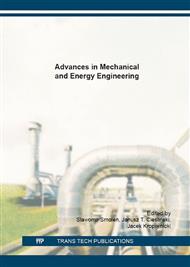p.25
p.33
p.44
p.54
p.63
p.71
p.83
p.92
p.104
Distribution of the Mechanical Properties of a Complexly Deformed Component of Low Carbon Steel Influenced by Post-Heat Treatment
Abstract:
The influence of post-heat treatment on the mechanical properties of complexly deformed low carbon steel is studied in this work to improve a forming process to ensure and enhance the overall product quality. Since there is no constant deformation degree, there are big differences in the mechanical properties within the part: material seen a high deformation degree shows increased strength but decreased ductility, which carries the risk of formation of cracks. A post heat treatment reduces that risk by reducing inner stresses and work/strain hardening. This study involves two steel component varying in thickness and forming process: stretching plus bending and stretching only. Post heat treatment after cold forming is necessary to provide the safety margin needed in the application. The forming process which consists of stretching only delivers a more uniform deformation over the length of the nozzle. However, adding bending to stretching keeps the deformation degree lower and leads to a more homogenous property distribution after annealing. Material only exposed to stretching shows strong softening by deforming above critical deformation degree with resulting values below initial properties. Even during annealing of around 40 min, recrystallization took part: more globular grains can be seen. Post heat treatment also homogenizes hardness over the cross-section of the work piece. Increased hardness towards the tension and compression surface side as a result of friction between tool and work piece should be avoided to provide the safety margin also on the more local level. Annealing retrieves the yield point phenomenon and strongly increases ductility up to 35 % and reduces the ratio of tensile yield strength to ultimate tensile strength to more moderate levels of around 0.6.
Info:
Periodical:
Pages:
63-70
Citation:
Online since:
April 2016
Authors:
Keywords:
Price:
Сopyright:
© 2016 Trans Tech Publications Ltd. All Rights Reserved
Share:
Citation:


